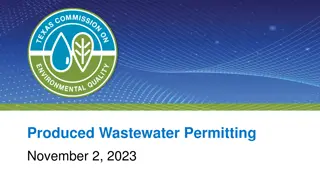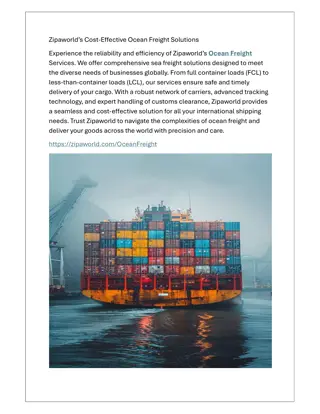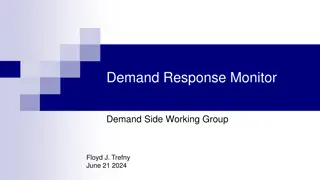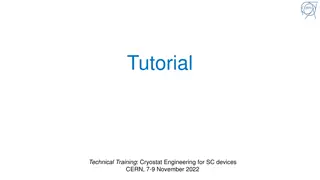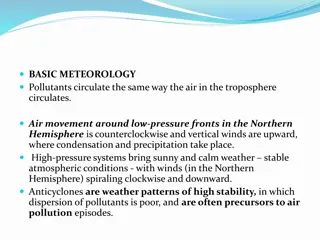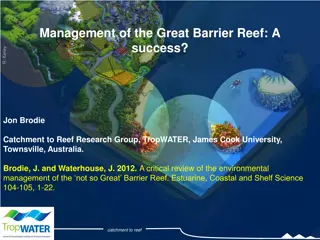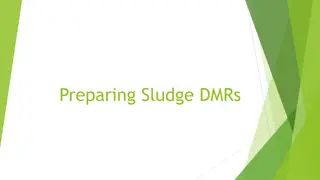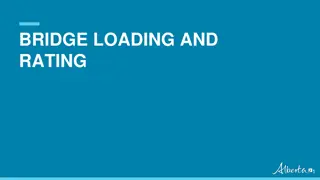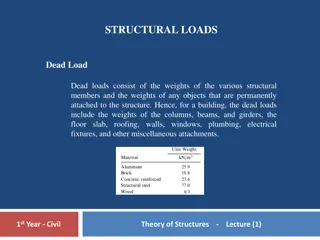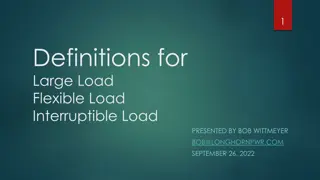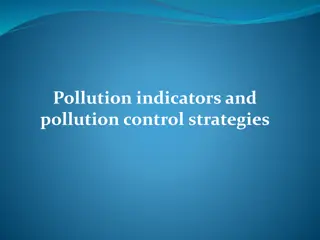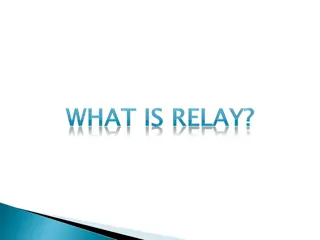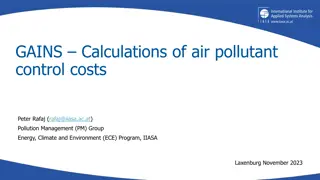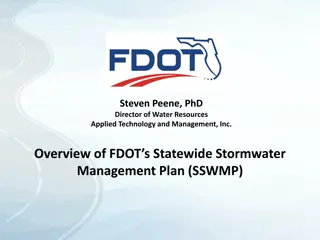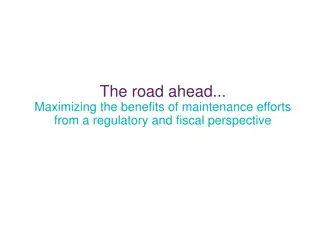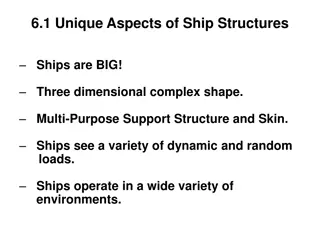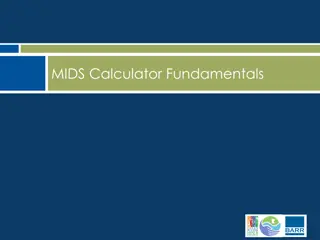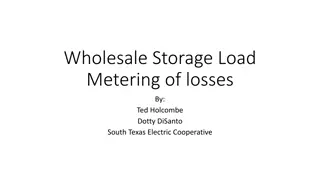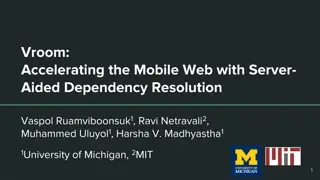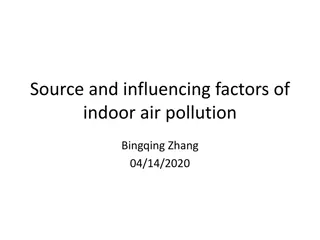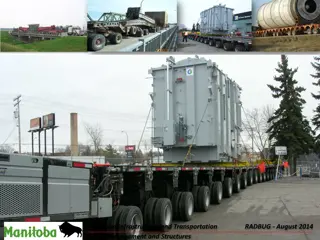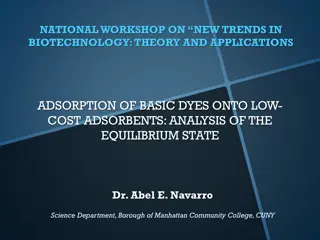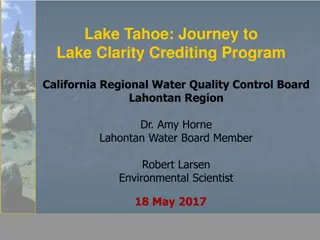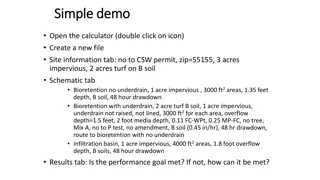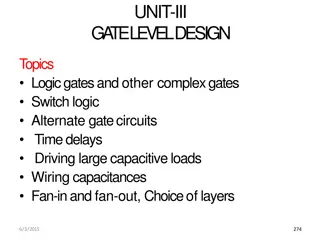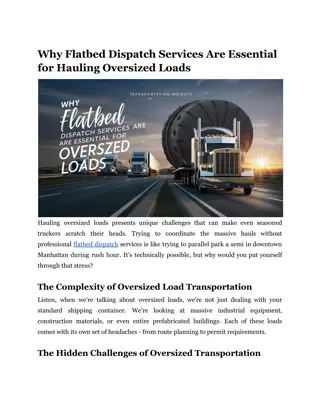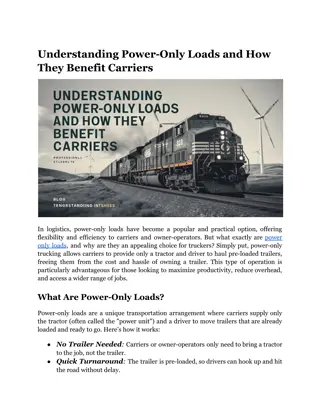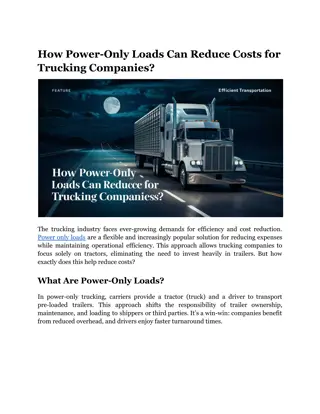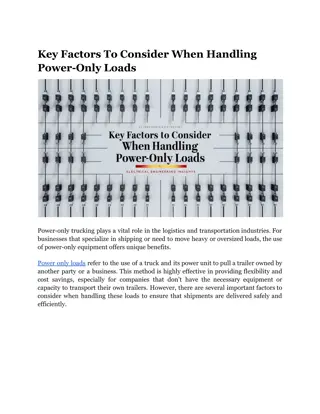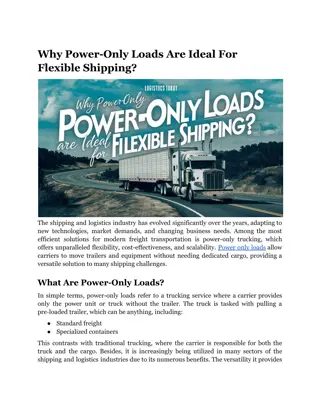BRIDGE LOADING AND RATING.
Bridges are subjected to various loads including dead load, live load, and other loads such as wind and temperature effects. The classification and characteristics of each load type are discussed. Additionally, the process of rating bridges to determine their load carrying capacity is explained. The
1 views • 21 slides
BASIC STRUCTURAL CONSIDERATIONS.
Bridge members must support various loads and stresses. This presentation covers how loads are applied, how members are stressed, and how materials resist stress. It discusses different member types like beams/girders, simple beams, continuous beams, and columns/hangers. Stresses such as tension, co
0 views • 34 slides
Floyd Trefny Proposal for Real-Time Settlement of Price-Sensitive Flexible Loads
The Floyd Trefny proposal aims to enhance real-time settlement for loads responsive to prices but not registered as controllable load resources. It suggests unique pricing based on Load Zone prices, impacting revenue allocation and benefiting responsive loads while possibly increasing costs for othe
1 views • 10 slides
Enhancing Air Quality Monitoring Through Multi-Pollutant Fusion System
AirFuse EPA's multi-pollutant fusion system, developed by Barron H. Henderson, Phil Dickerson, and co-authors, integrates data from AirNow, PurpleAir sensors, and satellites to improve air quality predictions. The system leverages real-time monitoring, satellite observations, and correction models t
2 views • 26 slides
Understanding TPDES Permits and Texas Wastewater Regulations
Learn about the Texas Pollutant Discharge Elimination System (TPDES) permits and regulations governing produced wastewater in Texas. Explore the authority of regulatory bodies like the Texas Commission on Environmental Quality (TCEQ) and Environmental Protection Agency (EPA). Discover management opt
1 views • 29 slides
BASIC STRUCTURAL CONSIDERATIONS
This presentation discusses the basic structural considerations for bridges, focusing on how loads are applied to members, how members are stressed by loads, and how materials resist stress. It covers various member types such as beams, girders, columns, and hangers, explaining the concepts of stres
9 views • 34 slides
Zipaworld’s Cost-Effective Ocean Freight Solutions
Experience the reliability and efficiency of Zipaworld\u2019s Ocean Freight Services. We offer comprehensive sea freight solutions designed to meet the diverse needs of businesses globally. From full container loads (FCL) to less-than-container loads (LCL), our services ensure safe and timely delive
1 views • 1 slides
Enhancing ERCOT's Capacity Assessment with Demand Response Monitoring
Demand response in ERCOT has been increasing, with forecasts of continued growth. The system operator can identify MW peaks by analyzing total ERCOT load data. A proposed Demand Response Monitor would assist in predicting future capacity needs based on responses from loads like LMP energy prices and
0 views • 7 slides
Cryostat Engineering for SC Devices Training at CERN - November 2022
Explore the technical training on Cryostat Engineering for Superconducting devices at CERN in November 2022. Dive into the design aspects, static heat loads, and mass flows for a 400 MHz cryomodule. Tasks include conceptual design of cryostats, calculating thermal parameters, supporting systems, and
0 views • 10 slides
Understanding Basic Meteorology Concepts for Air Quality Management
Pollutants circulate in the troposphere following air movement patterns around low-pressure fronts and high-pressure systems. Anticyclones and cyclones play a crucial role in atmospheric stability and pollutant dispersion. The relationship between lapse rates determines air stability and pollutant d
0 views • 24 slides
Environmental Challenges Facing the Great Barrier Reef
The management of the Great Barrier Reef has faced significant challenges leading to a decline in coral cover, dugong populations, seagrass health, and shark populations. Issues such as fishing practices, terrestrial pollutant runoff, and climate change have contributed to the deterioration of the r
0 views • 16 slides
Understanding Sludge Disposal Regulations in Oklahoma
Major facilities in Oklahoma must adhere to specific regulations when disposing of sludge, with two primary methods of disposal: Landfill and Land Applied. EDMRs must be submitted annually by February 19th, covering the previous year. Testing requirements include Toxicity Characteristic Leaching Pro
0 views • 30 slides
Understanding Bridge Loading and Rating
Bridges are subjected to various types of loads such as dead load, live load, and other loads like wind and temperature effects. Dead load consists of the bridge's self-weight, while live load includes temporary moving loads. Bridges are rated to determine their load carrying capacity, especially in
0 views • 21 slides
Understanding Structural Loads in Civil Engineering
Structural loads in civil engineering encompass dead loads from permanent structures, live loads that vary in magnitude and location, impact factors influencing rapid load application, wind loads due to blocked airflow, earthquake loads, and hydrostatic pressures for water-retaining structures. Thes
1 views • 6 slides
Understanding Definitions and Classifications for Large, Flexible, and Interruptible Loads in the Energy Industry
Exploring the definitions, requirements, and benefits of large, flexible, and interruptible loads in ERCOT processes. Learn why these classifications are necessary, how they differ from traditional loads, and the implications for grid reliability and system resiliency.
0 views • 9 slides
Understanding Xenobiotic Metabolism for Biomedical Applications
Metabolism of xenobiotics, foreign chemicals like drugs, food additives, and pollutants, is crucial for pharmacology, toxicology, and disease management. Knowledge allows for beneficial applications such as antioxidant research, pollutant conversion, and drug biosynthesis using transgenic organisms.
0 views • 11 slides
Understanding Pollution: Indicators and Control Strategies
Pollution is a significant environmental issue, yet often misunderstood. This article delves into the definition of pollution, classification, and considerations for effective pollution control strategies. It discusses the UK Environmental Protection Act of 1990, pollutant properties, toxicity, and
2 views • 50 slides
Guidelines for Design of Cement Concrete Pavement and Interlocking Paver Blocks
This document provides guidelines for designing cement concrete pavements and interlocking paver blocks, covering factors governing design, wheel loads, design period, subgrade characteristics, approximate k values based on CBR values, and the importance of a sub-base below concrete pavements. It em
0 views • 67 slides
Understanding the 5V Relay Module and Its Applications
A 5V relay module is an electrically activated switch commonly used in switching circuits for home automation projects, controlling heavy loads, safety circuits, and automotive electronics. This small relay board works with a 5V signal and can handle up to 10A of current for both AC and DC loads. It
1 views • 7 slides
GAINS Calculations of Air Pollutant Control Costs and Cost-Effective Technologies
This document provides insights into the GAINS calculations of annual costs for emission control technologies, including investment costs, fixed and variable operation and maintenance costs. It outlines specific cost information for technologies like Flue Gas Desulphurization (FGD), considering fact
0 views • 9 slides
Colorimetric Detection of Hydrogen Peroxide Using Magnetic Rod-Based Metal-Organic Framework Composites
Nanomaterials, particularly magnetic rod-based metal-organic frameworks composites, are gaining attention for their exceptional properties and various applications in different fields. This study by Benjamin Edem Meteku focuses on using these composites for colorimetric detection of hydrogen peroxid
0 views • 16 slides
Understanding FDOT's Statewide Stormwater Management Plan (SSWMP)
The Statewide Stormwater Management Plan (SSWMP) is a crucial document developed by FDOT to reduce pollutant discharge in Phase 1 MS4s. It is required under Phase I MS4 permits by FDEP's NPDES program and falls under the Clean Water Act. The SSWMP applies primarily in 15 Phase I Permit Counties but
1 views • 13 slides
Maximizing Maintenance Benefits for Environmental Compliance
Explore the significance of maintenance efforts in maximizing benefits from both regulatory and fiscal perspectives. Learn how routine maintenance activities such as pond cleaning, street sweeping, and litter control can lead to cost savings and regulatory compliance. Discover how keeping track of c
0 views • 18 slides
Understanding Unique Aspects of Ship Structures
Ships have complex three-dimensional shapes and support structures to withstand dynamic loads in various environments. Structural loads such as weight and buoyancy are distributed forces that affect shear stress in ship structures. Strategies to reduce shear stress include matching buoyancy and weig
0 views • 58 slides
Understanding MIDS Calculator Fundamentals and Performance Goals
The MIDS Calculator is a tool used to evaluate site conformance to MIDS performance goals, focusing on volume reduction and annual pollutant removal. It provides flexible treatment options tailored to site characteristics and goals. Learn about various simplifications of treatment options, jargon re
0 views • 59 slides
Chesapeake Bay Program Watershed Model Overview
The Chesapeake Bay Program's Watershed Model, presented to STAC in December 2019, provides insights on long-term average pollutant loads and land use dynamics in the Chesapeake Bay watershed. The model incorporates inputs such as land use acres, BMPs, and delivery mechanisms to estimate pollutant lo
0 views • 41 slides
Wholesale Storage Load Metering of Losses in Distributed Generation Battery Facility
Example system configuration in ERCOT involving a wholesale storage load metering system to track losses in a distributed interconnected generation battery facility. The system includes electrical storage systems, generation resources, and distribution generation components. Challenges arise in dete
0 views • 8 slides
Understanding Loads, Stress, and Strain in Materials Engineering
This content covers the classification of loads on materials including normal, shear, and torsion loads, as well as thermal loads. It further explains stress as the load per unit area and strain as the ratio of elongation of a material to its original length. The stress-strain diagram, along with th
0 views • 51 slides
Accelerating the Mobile Web with Server-Aided Dependency Resolution
This research discusses the challenges of slow web page loads on mobile devices, presenting a solution utilizing server-aided dependency resolution. It covers the impact of slow loading times on mobile web dominance, the importance of efficient resource loading, and the key factors influencing fast
0 views • 29 slides
Understanding Indoor Air Pollution: Sources, Impacts, and Control Measures
This study explores the sources and influencing factors of indoor air pollution, highlighting the importance of studying indoor air quality due to its critical impact on human health. It discusses the various pollutant categories from different sources such as outdoor elements, indoor sources, furni
0 views • 17 slides
Innovative Overload Permitting for Heavy Loads in Manitoba
Increased demand for hauling heavier loads in Manitoba has led to the development of innovative overload permitting processes by the Department of Infrastructure and Transportation. Using advanced design and load rating specifications, they approved a superload weighing 363,250 kg (800,830 lbs) for
0 views • 34 slides
Innovative Solutions for Pollution Control Using Natural Adsorbents
Workshop explores new trends in biotechnology for pollutant removal. Focus on adsorption of dyes onto low-cost adsorbents, with analysis of equilibrium state. Various techniques discussed include bioaccumulation, biosorption, and use of non-living biomasses. Emphasis on eco-friendly filtering techni
0 views • 18 slides
Understanding Lake Tahoe's Environmental Challenges
The Lake Tahoe Total Maximum Daily Load (TMDL) program aims to restore Lake Tahoe's clarity by addressing pollution sources such as nitrogen, phosphorus, and fine sediment particles. The program involves a science phase, regulatory strategy phase, and implementation phase to reduce pollutant loading
0 views • 27 slides
Stormwater Management Calculator Overview
Explore the functionalities of a stormwater management calculator that helps in analyzing stormwater runoff, pollutants, and BMP efficiencies. Learn about different BMP types, performance goals, and annual pollutant reduction targets to achieve effective stormwater management. Understand how the cal
0 views • 14 slides
Understanding Logic Gates and Large Load Driving in GA-TE Level Design
In GA-TE Level Design, the topics cover logic gates, complex gates, switch logic, gate circuits, timedelays, driving capacitive loads, wiring capacitances, fan-in and fan-out, choice of layers, NMOS and PMOS gate constructions, parasitics and performance impact, strategies for driving large loads, a
1 views • 21 slides
Why Flatbed Dispatch Services Are Essential for Hauling Oversized Loads
Discover why flatbed dispatch services are crucial for safely hauling oversized loads. Learn the key benefits and how they ensure efficient transport.
1 views • 6 slides
Understanding Power-Only Loads and How They Benefit Carriers
Discover how power-only loads work and their advantages for carriers in optimizing efficiency and expanding opportunities
0 views • 5 slides
How Power Only Loads Can Reduce Costs for Trucking Companies
Discover how power-only loads help trucking companies save costs, boost efficiency, and simplify logistics strategies.\n
0 views • 5 slides
Key Factors To Consider When Handling Power-Only Loads
Discover essential tips to manage power-only loads effectively. Learn how to optimize operations and ensure seamless transportation
0 views • 4 slides
Why Power-Only Loads Are Ideal for Flexible Shipping
Discover essential tips to manage power-only loads effectively. Learn how to optimize operations and ensure seamless transportation.\n
0 views • 4 slides




